Reflective Blog: Communication and Collaboration in Workplaces
VerifiedAdded on 2023/01/23
|9
|1968
|81
Report
AI Summary
This reflective blog examines the evolving nature of communication and collaboration in modern workplaces. It begins by outlining the shifts in work patterns driven by technological advancements, competitive pressures, and the move towards leaner, more agile organizational structures. The blog then delves into the major drivers of these changes, including customer-centricity and breakthroughs in mobile technology and high-speed internet. It explores models like the lean enterprise and cognitive competence, illustrating how companies are adapting to meet the demands of the modern business environment. The author reflects on their own interpersonal, communication, and collaborative skills, identifying areas for improvement such as self-awareness, empathy, and active listening. The blog emphasizes the importance of these skills in fostering effective teamwork and navigating the complexities of contemporary workplaces, providing real-world examples like the Denver Federal Center and Cisco Systems to demonstrate the impact of these changes.
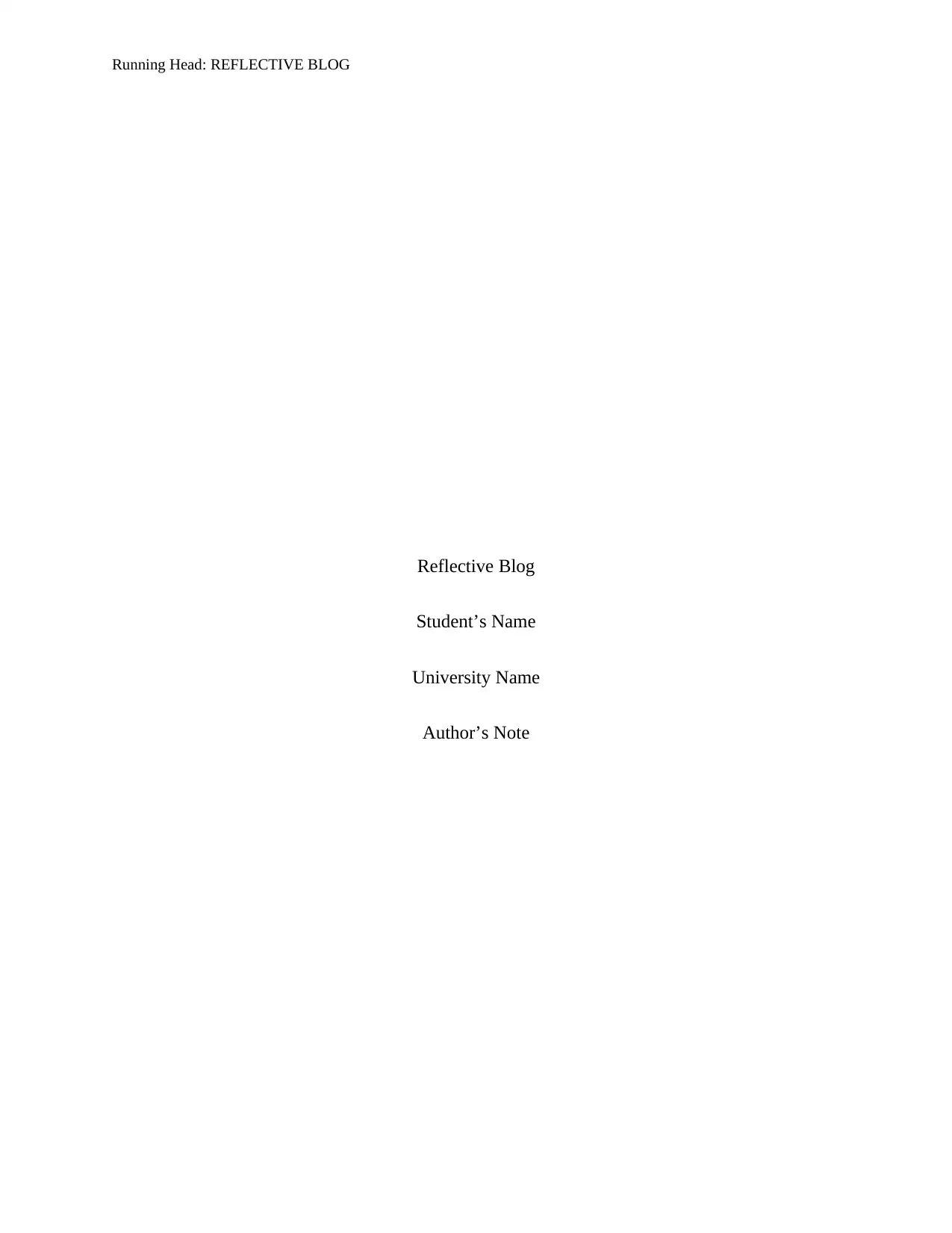
Running Head: REFLECTIVE BLOG
Reflective Blog
Student’s Name
University Name
Author’s Note
Reflective Blog
Student’s Name
University Name
Author’s Note
Paraphrase This Document
Need a fresh take? Get an instant paraphrase of this document with our AI Paraphraser
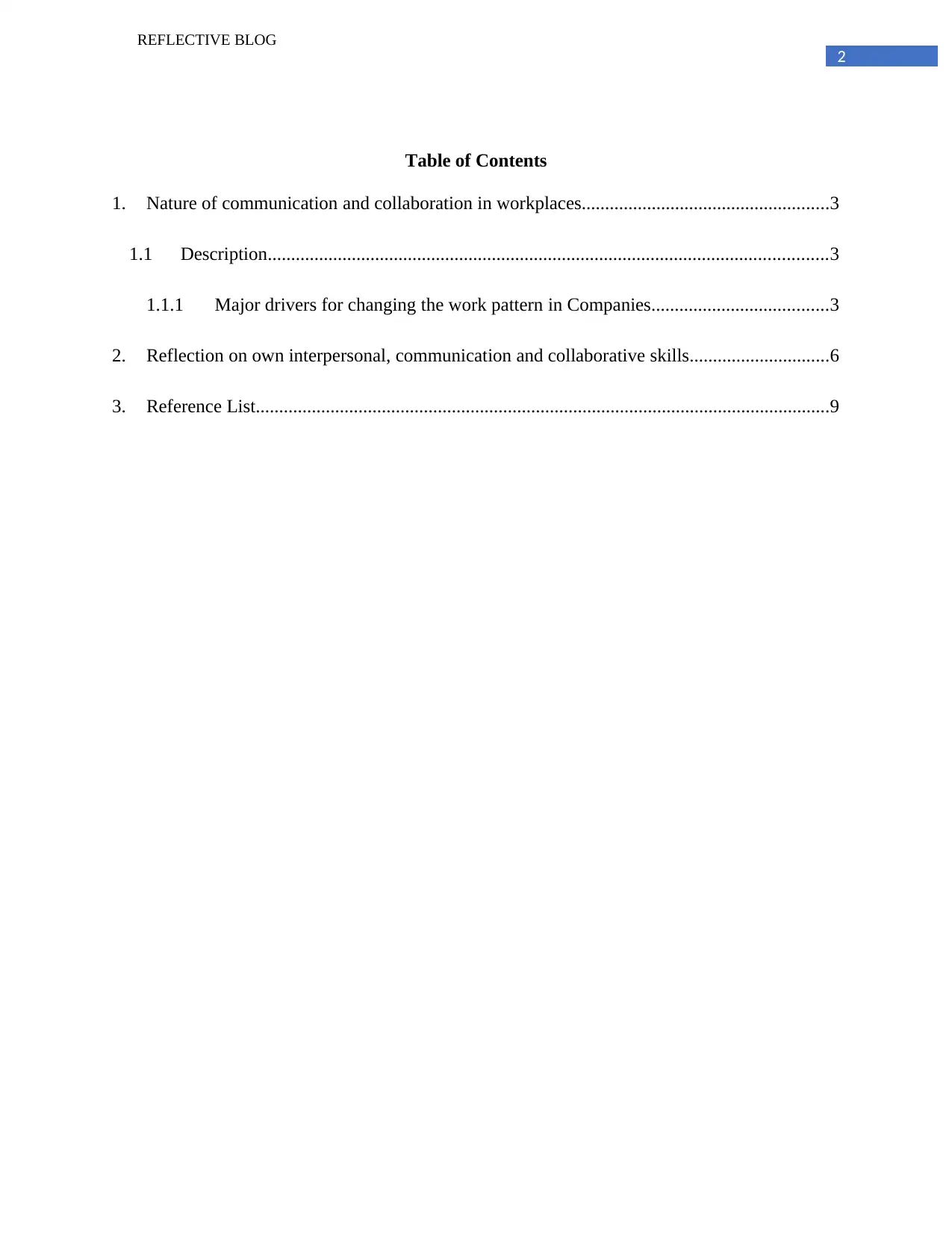
2
REFLECTIVE BLOG
Table of Contents
1. Nature of communication and collaboration in workplaces.....................................................3
1.1 Description........................................................................................................................3
1.1.1 Major drivers for changing the work pattern in Companies......................................3
2. Reflection on own interpersonal, communication and collaborative skills..............................6
3. Reference List...........................................................................................................................9
REFLECTIVE BLOG
Table of Contents
1. Nature of communication and collaboration in workplaces.....................................................3
1.1 Description........................................................................................................................3
1.1.1 Major drivers for changing the work pattern in Companies......................................3
2. Reflection on own interpersonal, communication and collaborative skills..............................6
3. Reference List...........................................................................................................................9
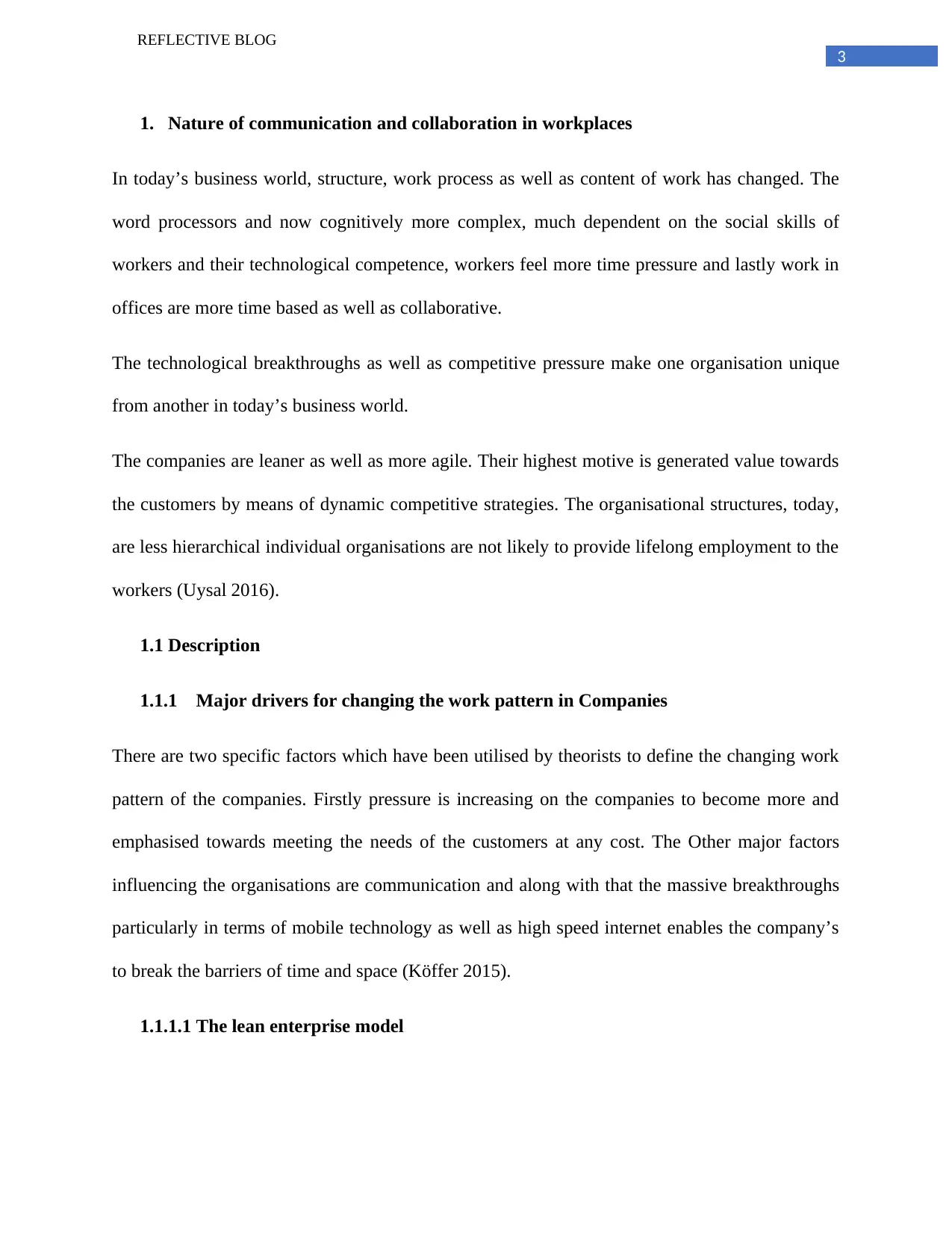
3
REFLECTIVE BLOG
1. Nature of communication and collaboration in workplaces
In today’s business world, structure, work process as well as content of work has changed. The
word processors and now cognitively more complex, much dependent on the social skills of
workers and their technological competence, workers feel more time pressure and lastly work in
offices are more time based as well as collaborative.
The technological breakthroughs as well as competitive pressure make one organisation unique
from another in today’s business world.
The companies are leaner as well as more agile. Their highest motive is generated value towards
the customers by means of dynamic competitive strategies. The organisational structures, today,
are less hierarchical individual organisations are not likely to provide lifelong employment to the
workers (Uysal 2016).
1.1 Description
1.1.1 Major drivers for changing the work pattern in Companies
There are two specific factors which have been utilised by theorists to define the changing work
pattern of the companies. Firstly pressure is increasing on the companies to become more and
emphasised towards meeting the needs of the customers at any cost. The Other major factors
influencing the organisations are communication and along with that the massive breakthroughs
particularly in terms of mobile technology as well as high speed internet enables the company’s
to break the barriers of time and space (Köffer 2015).
1.1.1.1 The lean enterprise model
REFLECTIVE BLOG
1. Nature of communication and collaboration in workplaces
In today’s business world, structure, work process as well as content of work has changed. The
word processors and now cognitively more complex, much dependent on the social skills of
workers and their technological competence, workers feel more time pressure and lastly work in
offices are more time based as well as collaborative.
The technological breakthroughs as well as competitive pressure make one organisation unique
from another in today’s business world.
The companies are leaner as well as more agile. Their highest motive is generated value towards
the customers by means of dynamic competitive strategies. The organisational structures, today,
are less hierarchical individual organisations are not likely to provide lifelong employment to the
workers (Uysal 2016).
1.1 Description
1.1.1 Major drivers for changing the work pattern in Companies
There are two specific factors which have been utilised by theorists to define the changing work
pattern of the companies. Firstly pressure is increasing on the companies to become more and
emphasised towards meeting the needs of the customers at any cost. The Other major factors
influencing the organisations are communication and along with that the massive breakthroughs
particularly in terms of mobile technology as well as high speed internet enables the company’s
to break the barriers of time and space (Köffer 2015).
1.1.1.1 The lean enterprise model
⊘ This is a preview!⊘
Do you want full access?
Subscribe today to unlock all pages.

Trusted by 1+ million students worldwide
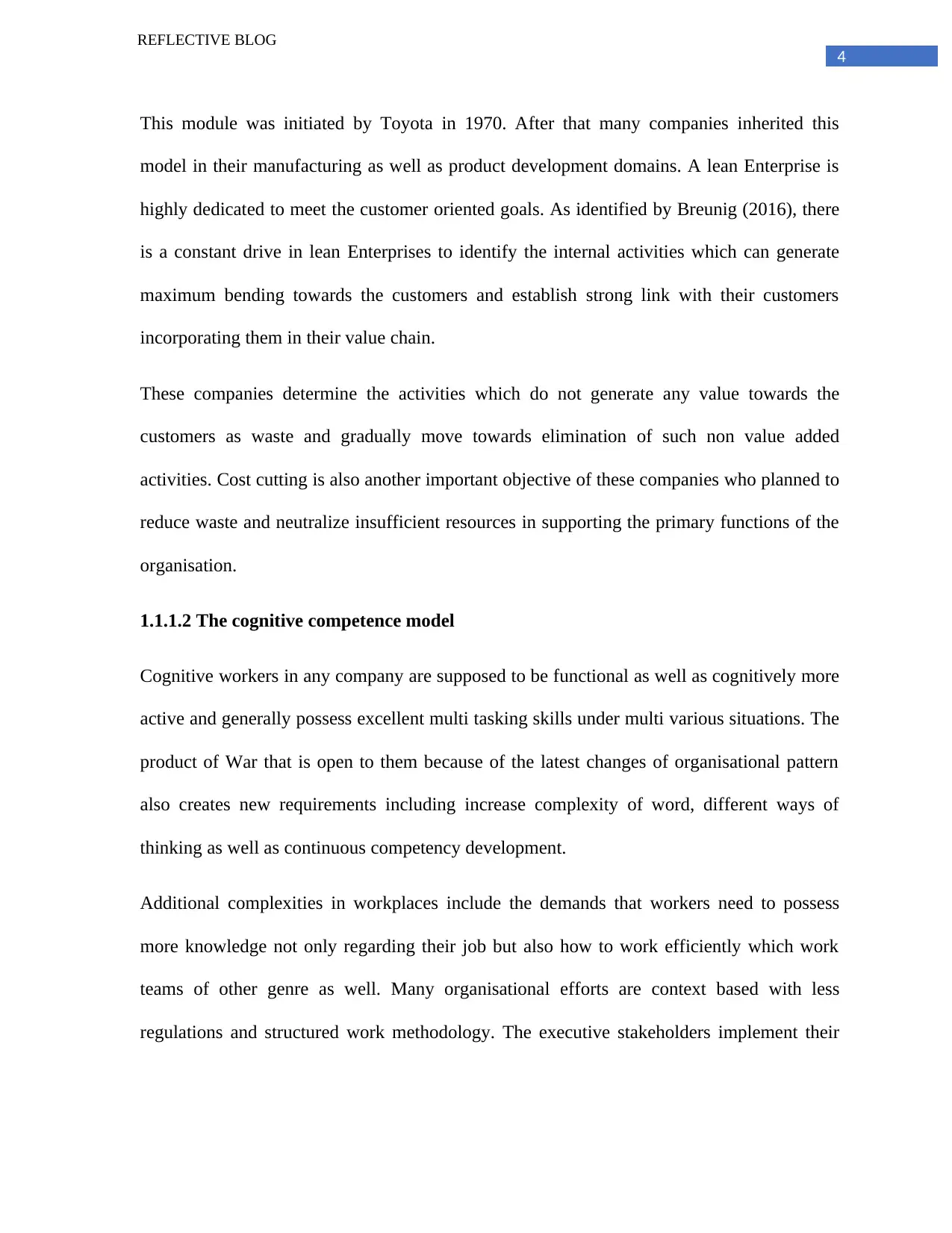
4
REFLECTIVE BLOG
This module was initiated by Toyota in 1970. After that many companies inherited this
model in their manufacturing as well as product development domains. A lean Enterprise is
highly dedicated to meet the customer oriented goals. As identified by Breunig (2016), there
is a constant drive in lean Enterprises to identify the internal activities which can generate
maximum bending towards the customers and establish strong link with their customers
incorporating them in their value chain.
These companies determine the activities which do not generate any value towards the
customers as waste and gradually move towards elimination of such non value added
activities. Cost cutting is also another important objective of these companies who planned to
reduce waste and neutralize insufficient resources in supporting the primary functions of the
organisation.
1.1.1.2 The cognitive competence model
Cognitive workers in any company are supposed to be functional as well as cognitively more
active and generally possess excellent multi tasking skills under multi various situations. The
product of War that is open to them because of the latest changes of organisational pattern
also creates new requirements including increase complexity of word, different ways of
thinking as well as continuous competency development.
Additional complexities in workplaces include the demands that workers need to possess
more knowledge not only regarding their job but also how to work efficiently which work
teams of other genre as well. Many organisational efforts are context based with less
regulations and structured work methodology. The executive stakeholders implement their
REFLECTIVE BLOG
This module was initiated by Toyota in 1970. After that many companies inherited this
model in their manufacturing as well as product development domains. A lean Enterprise is
highly dedicated to meet the customer oriented goals. As identified by Breunig (2016), there
is a constant drive in lean Enterprises to identify the internal activities which can generate
maximum bending towards the customers and establish strong link with their customers
incorporating them in their value chain.
These companies determine the activities which do not generate any value towards the
customers as waste and gradually move towards elimination of such non value added
activities. Cost cutting is also another important objective of these companies who planned to
reduce waste and neutralize insufficient resources in supporting the primary functions of the
organisation.
1.1.1.2 The cognitive competence model
Cognitive workers in any company are supposed to be functional as well as cognitively more
active and generally possess excellent multi tasking skills under multi various situations. The
product of War that is open to them because of the latest changes of organisational pattern
also creates new requirements including increase complexity of word, different ways of
thinking as well as continuous competency development.
Additional complexities in workplaces include the demands that workers need to possess
more knowledge not only regarding their job but also how to work efficiently which work
teams of other genre as well. Many organisational efforts are context based with less
regulations and structured work methodology. The executive stakeholders implement their
Paraphrase This Document
Need a fresh take? Get an instant paraphrase of this document with our AI Paraphraser
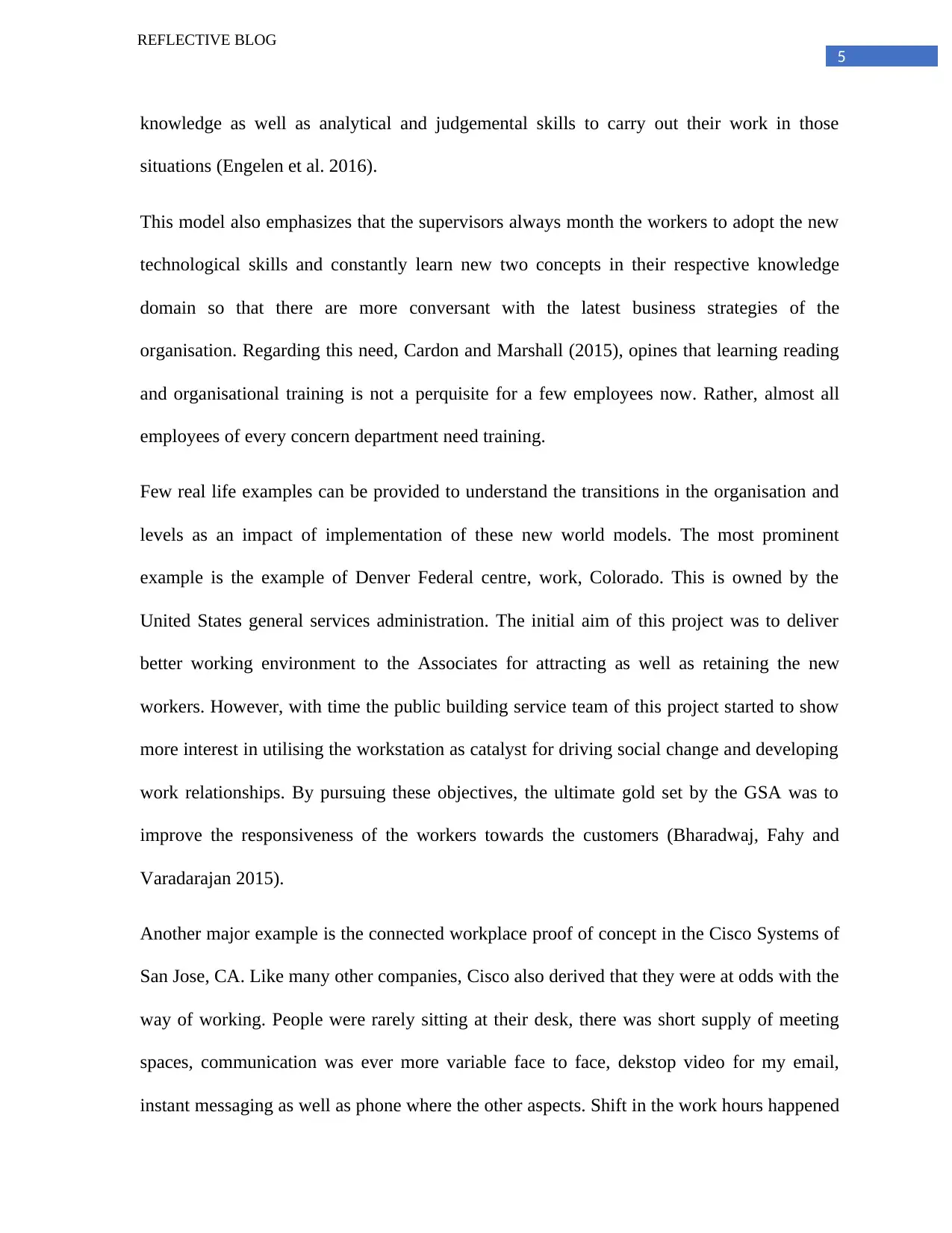
5
REFLECTIVE BLOG
knowledge as well as analytical and judgemental skills to carry out their work in those
situations (Engelen et al. 2016).
This model also emphasizes that the supervisors always month the workers to adopt the new
technological skills and constantly learn new two concepts in their respective knowledge
domain so that there are more conversant with the latest business strategies of the
organisation. Regarding this need, Cardon and Marshall (2015), opines that learning reading
and organisational training is not a perquisite for a few employees now. Rather, almost all
employees of every concern department need training.
Few real life examples can be provided to understand the transitions in the organisation and
levels as an impact of implementation of these new world models. The most prominent
example is the example of Denver Federal centre, work, Colorado. This is owned by the
United States general services administration. The initial aim of this project was to deliver
better working environment to the Associates for attracting as well as retaining the new
workers. However, with time the public building service team of this project started to show
more interest in utilising the workstation as catalyst for driving social change and developing
work relationships. By pursuing these objectives, the ultimate gold set by the GSA was to
improve the responsiveness of the workers towards the customers (Bharadwaj, Fahy and
Varadarajan 2015).
Another major example is the connected workplace proof of concept in the Cisco Systems of
San Jose, CA. Like many other companies, Cisco also derived that they were at odds with the
way of working. People were rarely sitting at their desk, there was short supply of meeting
spaces, communication was ever more variable face to face, dekstop video for my email,
instant messaging as well as phone where the other aspects. Shift in the work hours happened
REFLECTIVE BLOG
knowledge as well as analytical and judgemental skills to carry out their work in those
situations (Engelen et al. 2016).
This model also emphasizes that the supervisors always month the workers to adopt the new
technological skills and constantly learn new two concepts in their respective knowledge
domain so that there are more conversant with the latest business strategies of the
organisation. Regarding this need, Cardon and Marshall (2015), opines that learning reading
and organisational training is not a perquisite for a few employees now. Rather, almost all
employees of every concern department need training.
Few real life examples can be provided to understand the transitions in the organisation and
levels as an impact of implementation of these new world models. The most prominent
example is the example of Denver Federal centre, work, Colorado. This is owned by the
United States general services administration. The initial aim of this project was to deliver
better working environment to the Associates for attracting as well as retaining the new
workers. However, with time the public building service team of this project started to show
more interest in utilising the workstation as catalyst for driving social change and developing
work relationships. By pursuing these objectives, the ultimate gold set by the GSA was to
improve the responsiveness of the workers towards the customers (Bharadwaj, Fahy and
Varadarajan 2015).
Another major example is the connected workplace proof of concept in the Cisco Systems of
San Jose, CA. Like many other companies, Cisco also derived that they were at odds with the
way of working. People were rarely sitting at their desk, there was short supply of meeting
spaces, communication was ever more variable face to face, dekstop video for my email,
instant messaging as well as phone where the other aspects. Shift in the work hours happened
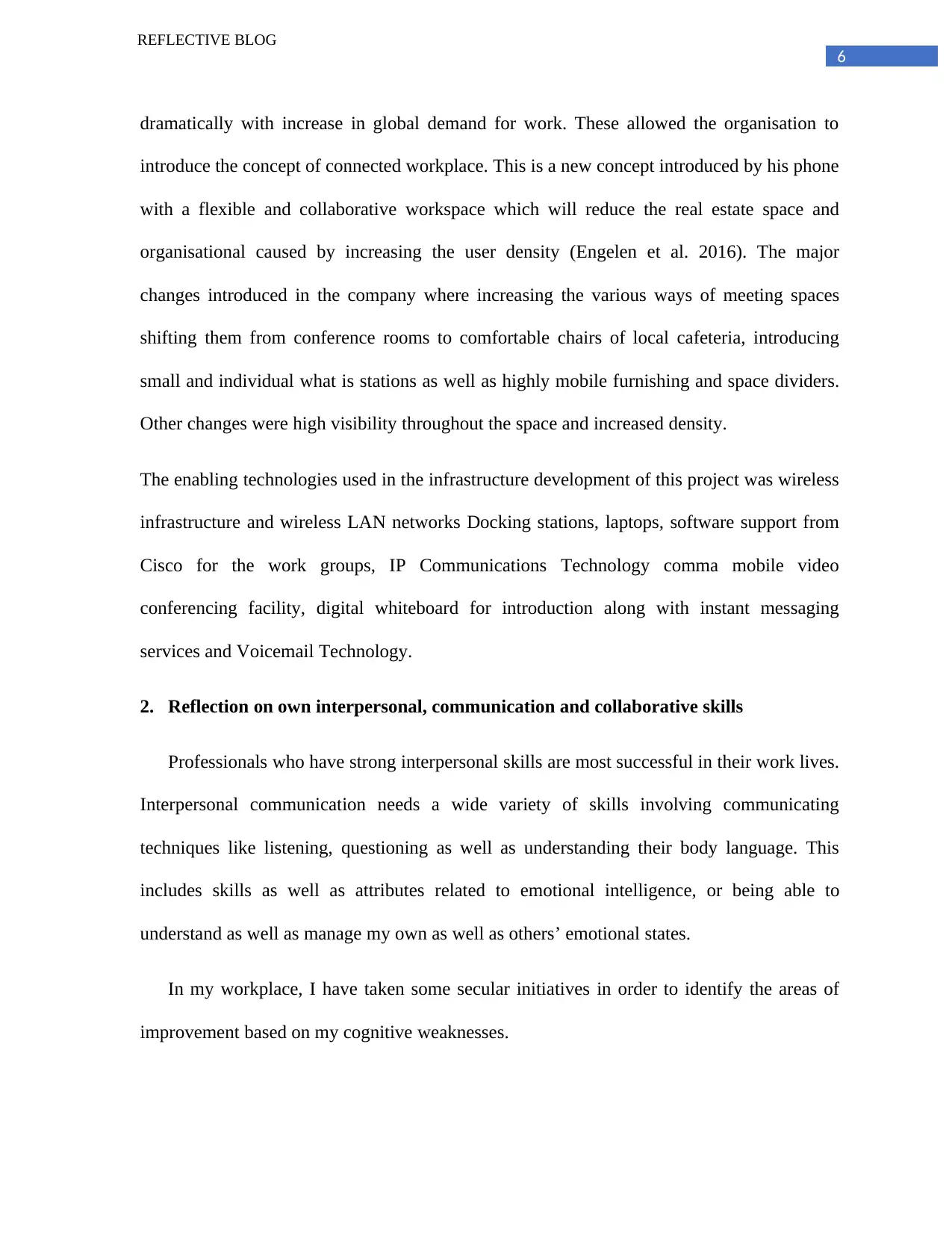
6
REFLECTIVE BLOG
dramatically with increase in global demand for work. These allowed the organisation to
introduce the concept of connected workplace. This is a new concept introduced by his phone
with a flexible and collaborative workspace which will reduce the real estate space and
organisational caused by increasing the user density (Engelen et al. 2016). The major
changes introduced in the company where increasing the various ways of meeting spaces
shifting them from conference rooms to comfortable chairs of local cafeteria, introducing
small and individual what is stations as well as highly mobile furnishing and space dividers.
Other changes were high visibility throughout the space and increased density.
The enabling technologies used in the infrastructure development of this project was wireless
infrastructure and wireless LAN networks Docking stations, laptops, software support from
Cisco for the work groups, IP Communications Technology comma mobile video
conferencing facility, digital whiteboard for introduction along with instant messaging
services and Voicemail Technology.
2. Reflection on own interpersonal, communication and collaborative skills
Professionals who have strong interpersonal skills are most successful in their work lives.
Interpersonal communication needs a wide variety of skills involving communicating
techniques like listening, questioning as well as understanding their body language. This
includes skills as well as attributes related to emotional intelligence, or being able to
understand as well as manage my own as well as others’ emotional states.
In my workplace, I have taken some secular initiatives in order to identify the areas of
improvement based on my cognitive weaknesses.
REFLECTIVE BLOG
dramatically with increase in global demand for work. These allowed the organisation to
introduce the concept of connected workplace. This is a new concept introduced by his phone
with a flexible and collaborative workspace which will reduce the real estate space and
organisational caused by increasing the user density (Engelen et al. 2016). The major
changes introduced in the company where increasing the various ways of meeting spaces
shifting them from conference rooms to comfortable chairs of local cafeteria, introducing
small and individual what is stations as well as highly mobile furnishing and space dividers.
Other changes were high visibility throughout the space and increased density.
The enabling technologies used in the infrastructure development of this project was wireless
infrastructure and wireless LAN networks Docking stations, laptops, software support from
Cisco for the work groups, IP Communications Technology comma mobile video
conferencing facility, digital whiteboard for introduction along with instant messaging
services and Voicemail Technology.
2. Reflection on own interpersonal, communication and collaborative skills
Professionals who have strong interpersonal skills are most successful in their work lives.
Interpersonal communication needs a wide variety of skills involving communicating
techniques like listening, questioning as well as understanding their body language. This
includes skills as well as attributes related to emotional intelligence, or being able to
understand as well as manage my own as well as others’ emotional states.
In my workplace, I have taken some secular initiatives in order to identify the areas of
improvement based on my cognitive weaknesses.
⊘ This is a preview!⊘
Do you want full access?
Subscribe today to unlock all pages.

Trusted by 1+ million students worldwide
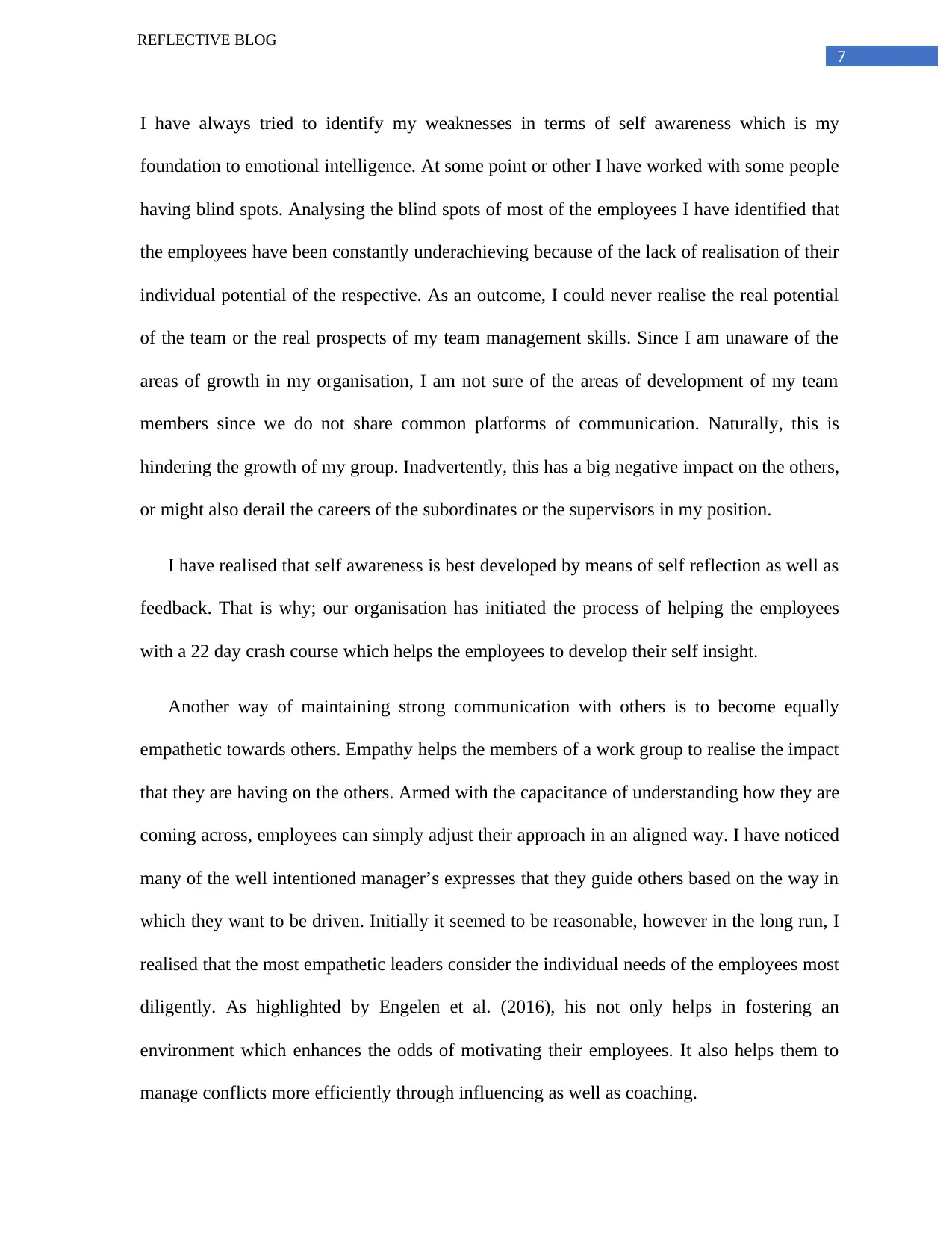
7
REFLECTIVE BLOG
I have always tried to identify my weaknesses in terms of self awareness which is my
foundation to emotional intelligence. At some point or other I have worked with some people
having blind spots. Analysing the blind spots of most of the employees I have identified that
the employees have been constantly underachieving because of the lack of realisation of their
individual potential of the respective. As an outcome, I could never realise the real potential
of the team or the real prospects of my team management skills. Since I am unaware of the
areas of growth in my organisation, I am not sure of the areas of development of my team
members since we do not share common platforms of communication. Naturally, this is
hindering the growth of my group. Inadvertently, this has a big negative impact on the others,
or might also derail the careers of the subordinates or the supervisors in my position.
I have realised that self awareness is best developed by means of self reflection as well as
feedback. That is why; our organisation has initiated the process of helping the employees
with a 22 day crash course which helps the employees to develop their self insight.
Another way of maintaining strong communication with others is to become equally
empathetic towards others. Empathy helps the members of a work group to realise the impact
that they are having on the others. Armed with the capacitance of understanding how they are
coming across, employees can simply adjust their approach in an aligned way. I have noticed
many of the well intentioned manager’s expresses that they guide others based on the way in
which they want to be driven. Initially it seemed to be reasonable, however in the long run, I
realised that the most empathetic leaders consider the individual needs of the employees most
diligently. As highlighted by Engelen et al. (2016), his not only helps in fostering an
environment which enhances the odds of motivating their employees. It also helps them to
manage conflicts more efficiently through influencing as well as coaching.
REFLECTIVE BLOG
I have always tried to identify my weaknesses in terms of self awareness which is my
foundation to emotional intelligence. At some point or other I have worked with some people
having blind spots. Analysing the blind spots of most of the employees I have identified that
the employees have been constantly underachieving because of the lack of realisation of their
individual potential of the respective. As an outcome, I could never realise the real potential
of the team or the real prospects of my team management skills. Since I am unaware of the
areas of growth in my organisation, I am not sure of the areas of development of my team
members since we do not share common platforms of communication. Naturally, this is
hindering the growth of my group. Inadvertently, this has a big negative impact on the others,
or might also derail the careers of the subordinates or the supervisors in my position.
I have realised that self awareness is best developed by means of self reflection as well as
feedback. That is why; our organisation has initiated the process of helping the employees
with a 22 day crash course which helps the employees to develop their self insight.
Another way of maintaining strong communication with others is to become equally
empathetic towards others. Empathy helps the members of a work group to realise the impact
that they are having on the others. Armed with the capacitance of understanding how they are
coming across, employees can simply adjust their approach in an aligned way. I have noticed
many of the well intentioned manager’s expresses that they guide others based on the way in
which they want to be driven. Initially it seemed to be reasonable, however in the long run, I
realised that the most empathetic leaders consider the individual needs of the employees most
diligently. As highlighted by Engelen et al. (2016), his not only helps in fostering an
environment which enhances the odds of motivating their employees. It also helps them to
manage conflicts more efficiently through influencing as well as coaching.
Paraphrase This Document
Need a fresh take? Get an instant paraphrase of this document with our AI Paraphraser
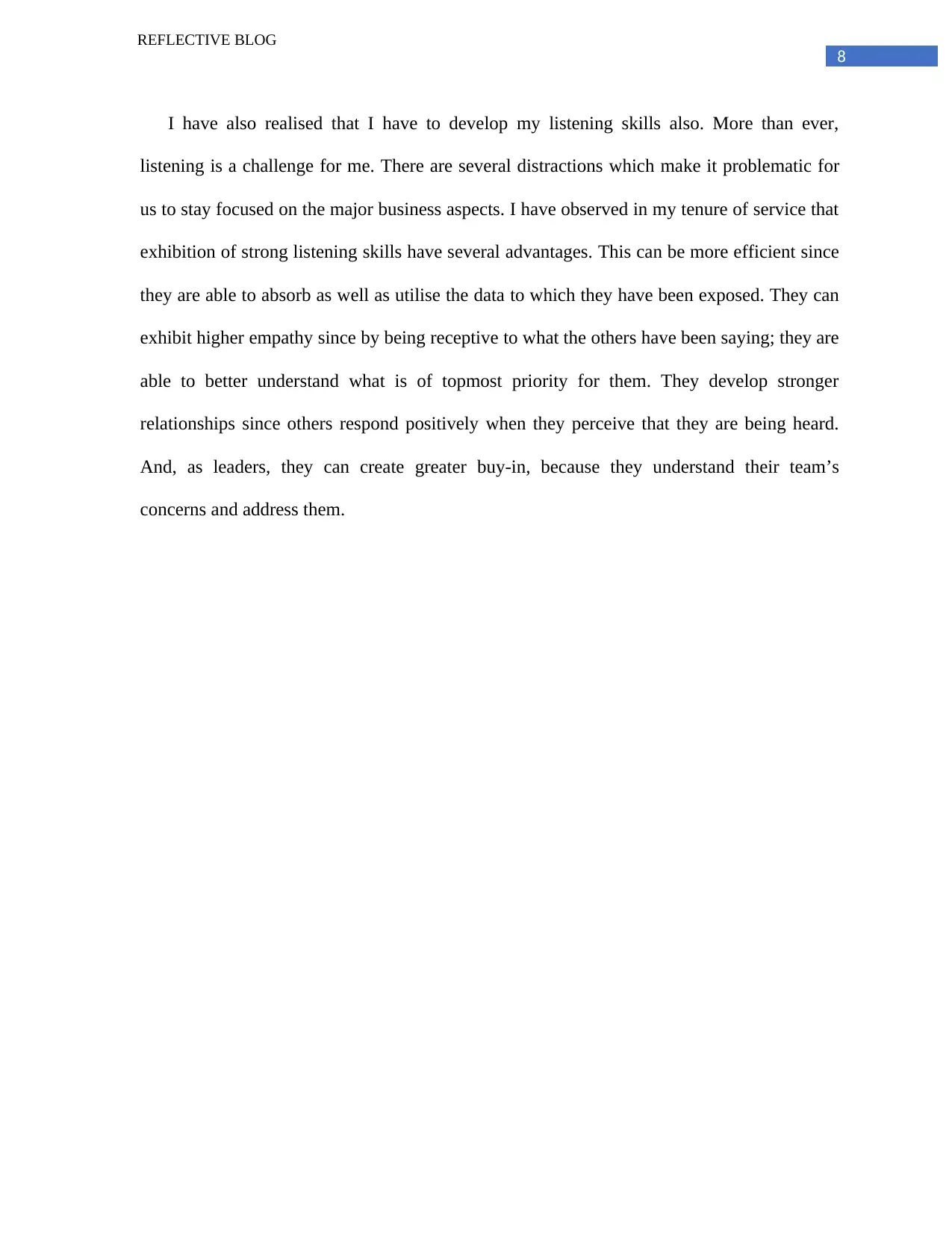
8
REFLECTIVE BLOG
I have also realised that I have to develop my listening skills also. More than ever,
listening is a challenge for me. There are several distractions which make it problematic for
us to stay focused on the major business aspects. I have observed in my tenure of service that
exhibition of strong listening skills have several advantages. This can be more efficient since
they are able to absorb as well as utilise the data to which they have been exposed. They can
exhibit higher empathy since by being receptive to what the others have been saying; they are
able to better understand what is of topmost priority for them. They develop stronger
relationships since others respond positively when they perceive that they are being heard.
And, as leaders, they can create greater buy-in, because they understand their team’s
concerns and address them.
REFLECTIVE BLOG
I have also realised that I have to develop my listening skills also. More than ever,
listening is a challenge for me. There are several distractions which make it problematic for
us to stay focused on the major business aspects. I have observed in my tenure of service that
exhibition of strong listening skills have several advantages. This can be more efficient since
they are able to absorb as well as utilise the data to which they have been exposed. They can
exhibit higher empathy since by being receptive to what the others have been saying; they are
able to better understand what is of topmost priority for them. They develop stronger
relationships since others respond positively when they perceive that they are being heard.
And, as leaders, they can create greater buy-in, because they understand their team’s
concerns and address them.
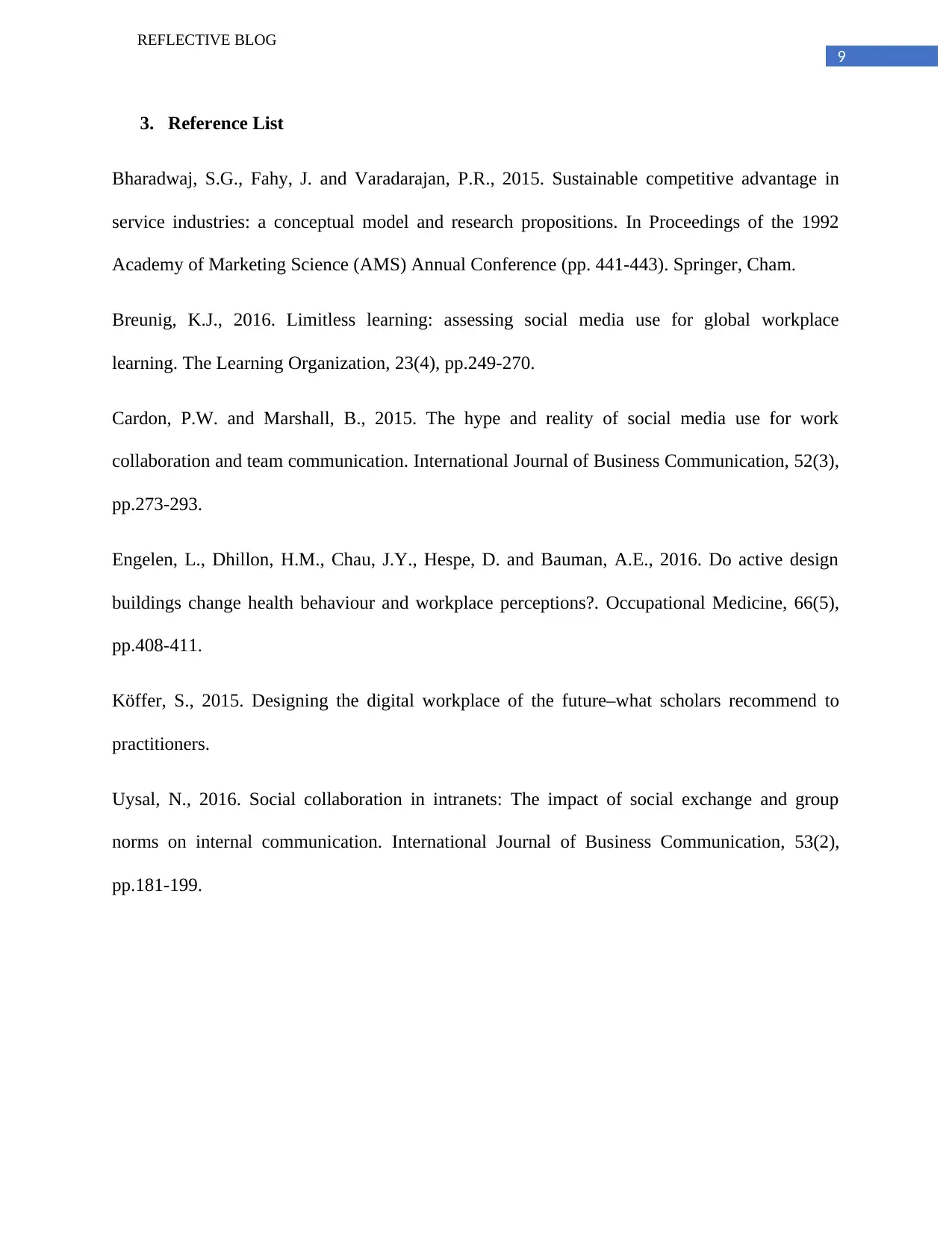
9
REFLECTIVE BLOG
3. Reference List
Bharadwaj, S.G., Fahy, J. and Varadarajan, P.R., 2015. Sustainable competitive advantage in
service industries: a conceptual model and research propositions. In Proceedings of the 1992
Academy of Marketing Science (AMS) Annual Conference (pp. 441-443). Springer, Cham.
Breunig, K.J., 2016. Limitless learning: assessing social media use for global workplace
learning. The Learning Organization, 23(4), pp.249-270.
Cardon, P.W. and Marshall, B., 2015. The hype and reality of social media use for work
collaboration and team communication. International Journal of Business Communication, 52(3),
pp.273-293.
Engelen, L., Dhillon, H.M., Chau, J.Y., Hespe, D. and Bauman, A.E., 2016. Do active design
buildings change health behaviour and workplace perceptions?. Occupational Medicine, 66(5),
pp.408-411.
Köffer, S., 2015. Designing the digital workplace of the future–what scholars recommend to
practitioners.
Uysal, N., 2016. Social collaboration in intranets: The impact of social exchange and group
norms on internal communication. International Journal of Business Communication, 53(2),
pp.181-199.
REFLECTIVE BLOG
3. Reference List
Bharadwaj, S.G., Fahy, J. and Varadarajan, P.R., 2015. Sustainable competitive advantage in
service industries: a conceptual model and research propositions. In Proceedings of the 1992
Academy of Marketing Science (AMS) Annual Conference (pp. 441-443). Springer, Cham.
Breunig, K.J., 2016. Limitless learning: assessing social media use for global workplace
learning. The Learning Organization, 23(4), pp.249-270.
Cardon, P.W. and Marshall, B., 2015. The hype and reality of social media use for work
collaboration and team communication. International Journal of Business Communication, 52(3),
pp.273-293.
Engelen, L., Dhillon, H.M., Chau, J.Y., Hespe, D. and Bauman, A.E., 2016. Do active design
buildings change health behaviour and workplace perceptions?. Occupational Medicine, 66(5),
pp.408-411.
Köffer, S., 2015. Designing the digital workplace of the future–what scholars recommend to
practitioners.
Uysal, N., 2016. Social collaboration in intranets: The impact of social exchange and group
norms on internal communication. International Journal of Business Communication, 53(2),
pp.181-199.
⊘ This is a preview!⊘
Do you want full access?
Subscribe today to unlock all pages.

Trusted by 1+ million students worldwide
1 out of 9
Related Documents
Your All-in-One AI-Powered Toolkit for Academic Success.
+13062052269
info@desklib.com
Available 24*7 on WhatsApp / Email
![[object Object]](/_next/static/media/star-bottom.7253800d.svg)
Unlock your academic potential
Copyright © 2020–2025 A2Z Services. All Rights Reserved. Developed and managed by ZUCOL.





